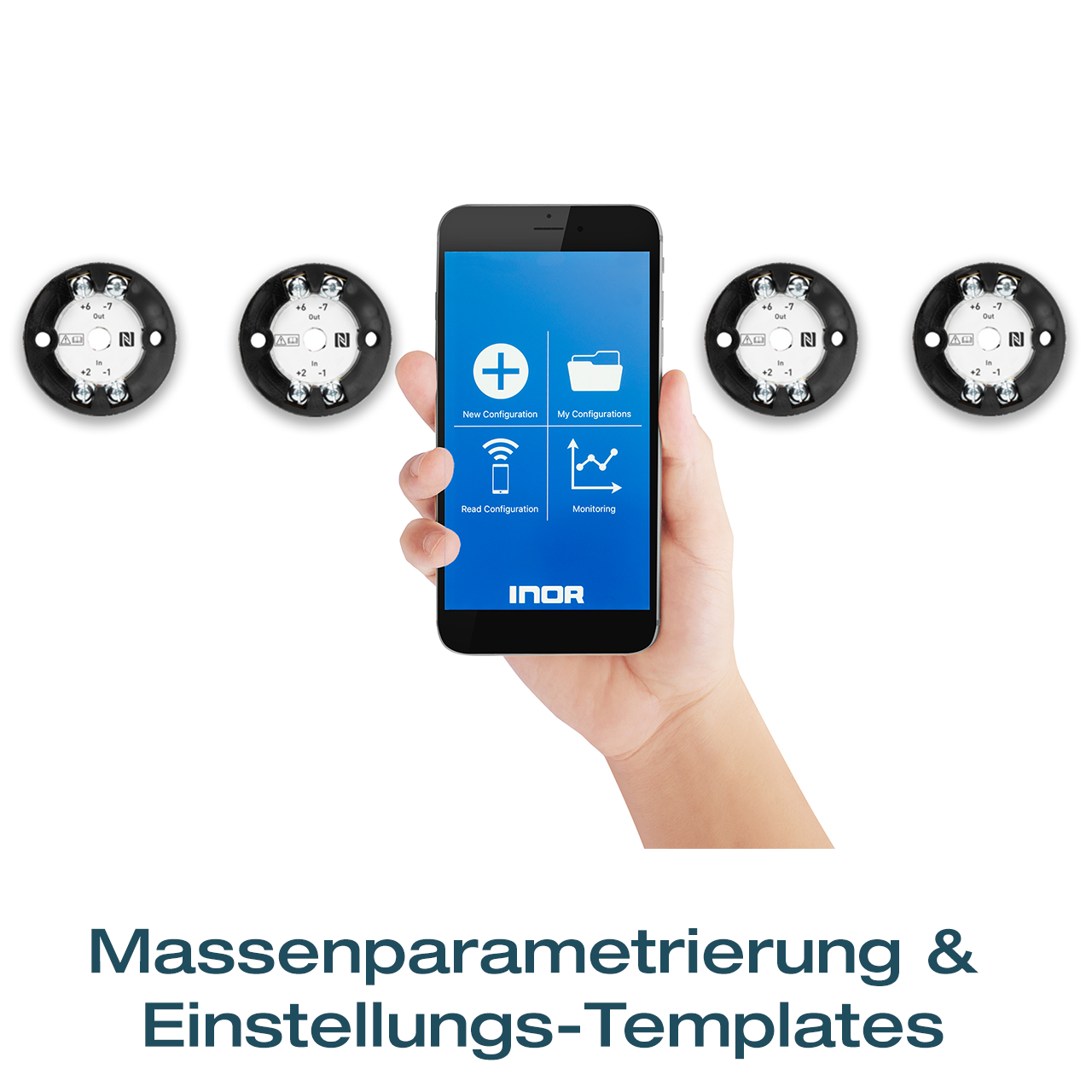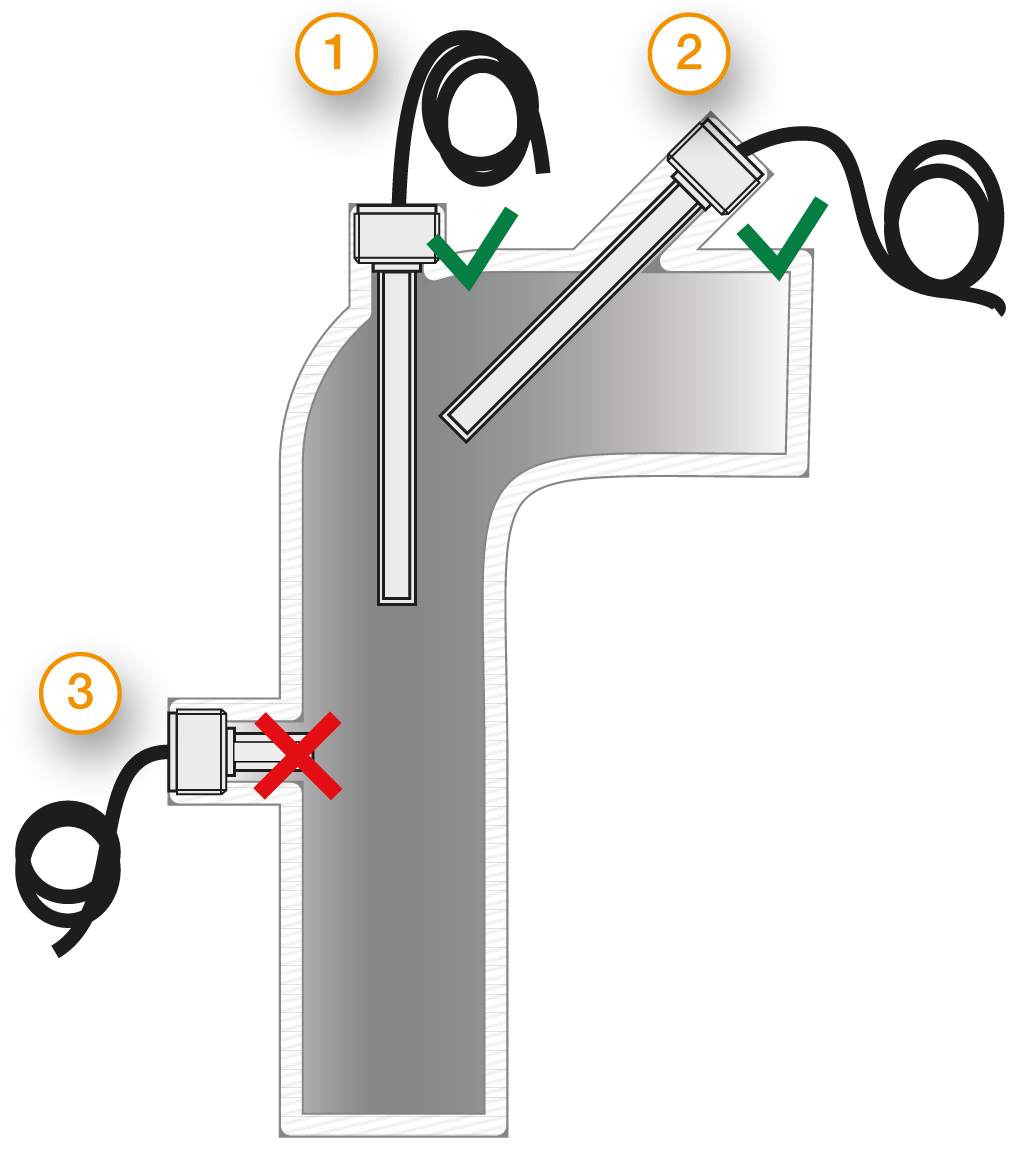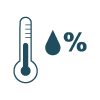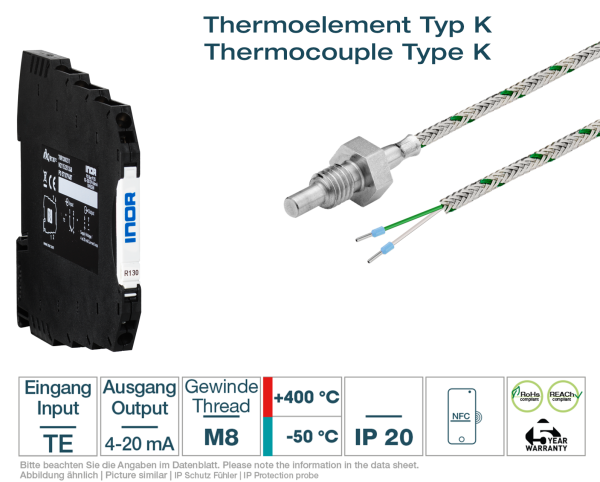Prices plus VAT plus shipping costs of 4,95 € to GER (incl. VAT)
Delivery time 5 Workdays to NL, BE, AT (GER -1 workdays)

Bitte stellen Sie sicher, dass die technischen Daten der Anschlussleitung, insbesondere hinsichtlich Temperatur und IP-Schutzklasse, zu Ihrer Applikation passen. Detailierte Informationen finden Sie in unseren Datenblättern.
Temperaturbereiche unserer Leitungen:
Glasseide: -50 °C bis +400 °C










Bitte beachten Sie den spezifizierten Temperaturbereich des Stecker / der Aderendenhülsen
isolierte Aderendhülsen: bis 80 °C
Mini-TE-Stecker: bis 220 °C
TE-Stecker: bis 220 °C


| Ihr passender Hutschienen-Transmitter: | ||
| E - Material Anschlussleitung: | ||
| F - Länge Leitung: | ||
| G - Stecker: | ||
| H - Knickschutz: | ||
| Menge: |
- Order number: 803181-3291





Advantages
- We are ready to deliver: All information here
- Advice directly from experts
- Quality directly from the manufacturer
- Long-term stable temperature probes over years
- B2B customers welcome: All information here

Our employee will be happy to help you:
Julian Mäntele
Tel.: +49 (0)7653 96 59 771
E-Mail: jmaentele@testo-sensor.de
Active cable thermocouples are equipped with a temperature transmitter in DIN rail form. They convert the thermoelectric voltage into a standardized signal (mA). This means that the temperature measurement signals can always be transmitted safely, easily and even over longer distances to your control or display. Screw-in thermocouples with glass fibre cables are shielded and measure the temperature in pipelines or vessels up to +400 °C. They are crimped and also have a poorer seal than other cables due to the insulation material used.
________________________________
The APAQ R130 TC for thermocouples is a DIN rail transmitter for installation on standard DIN rails according to DIN EN50022. The sophisticated product design leaves sufficient space for mounting. It is optimally designed for use in plant and machine construction and is characterized by high accuracy, reliability, long-term stability and its robust product design. The transmitter is extremely insensitive to external influences such as vibration and EMC interference. Installation and commissioning are particularly user-friendly. For example, parameterization can be carried out wirelessly, conveniently and easily via the cell phone app using NFC technology. The monitoring functions such as sensor break monitoring, sensor short-circuit and measuring range monitoring can also be activated via this.
Here you can find our downloads for Hat rail transmitter for thermocouples APAQ-R130
Hat rail transmitter - Special features | ||||||||||||||||
| Inputs and outputs | Input: thermocouples Output: 4 to 20mA, temperature linear output signal | |||||||||||||||
| Accuracy & Long-term stability | Accuracy: depending on thermocouple Long-term stability: max drift of ±0.05°C or ±0.05% of span |year | |||||||||||||||
| Design | Robust - vibration and shock resistant design Suitable for hat rails according to DIN EN50022 Compact housing design Facilitated mounting | |||||||||||||||
| Parametrization | Configuration - wireless via NFC technology Free app for Iphone, Android & Huawei Parameterization templates for fast mass configuration Simple configuration with "copy and paste" in no time at all  | |||||||||||||||
| Alarm function | configurable via app Sensor break monitoring Sensor short circuit Measuring range monitoring | |||||||||||||||
Hat rail transmitter - Input Thermocouple | ||||||||||||||||
| Measuring element | Material / Raw Material | Norm | Maximum configurable measuring range | Min. Span | Accuracy | |||||||||||
| Type B | Pt30Rh-Pt6Rh | IEC 60584 | 0 °C to +1820 °C 32 °F to +3308 °F | +700 °C | +1292 °F | +100 °C to +400 °C: ±10 °C >400 °C: ±2 °C / 0,2% 1} | |||||||||||
| Type E | NiCr-CuNi | IEC 60584 | -270 °C to +1000 °C -454 °F to +1832 °F | +50 °C | +122 °F | ±1 °C| ±0,2 % 1} | |||||||||||
| Type J | Fe-CuNi | IEC 60584 | -210 °C to +1200 °C -346 °F to +2192 °F | +50 °C | +122 °F | ±1 °C| ±0,2 % 1} | |||||||||||
| Type K | NiCr-Ni | IEC 60584 | -270 °C to +1300 °C -454 °F to +2372 °F | +50 °C | +122 °F | ±1 °C| ±0,2 % 1} | |||||||||||
| Type N | NiCrSi-NiSi | IEC 60584 | -100 °C to +1300 °C -148 °F to +2372 °F | +100 °C | +212 °F | ±1 °C| ±0,2 % 1} | |||||||||||
| Type N | NiCrSi-NiSi | IEC 60584 | -270 °C to -100 °C -418 °F to +148 °F | +100 °C | +212 °F | ±2 °C 1} | |||||||||||
| Type R | Pt13Rh-Pt | IEC 60584 | -50 °C to +1750 °C -58 °F to +3182 °F | +300 °C | +572 °F | ±2 °C| ±0,2 % 1} | |||||||||||
| Type S | Pt10Rh-Pt | IEC 60584 | -50 °C to +1750 °C -58 °F to +3182 °F | +300 °C | +572 °F | ±2 °C| ±0,2 % 1} | |||||||||||
| Type T | Cu-CuNi | IEC 60584 | -270 °C to +400 °C -454 °F to +752 °F | +50 °C | +122 °F | ±2 °C| ±0,2 % 1} | |||||||||||
| 1} of span (cold junction compensation error is not included) | ||||||||||||||||
| Input impedance | >10 MΩ | |||||||||||||||
| Max. wire loop resistance | 5 kΩ | |||||||||||||||
| Cold Junction Compensation | Internal or external | |||||||||||||||
Hat rail transmitter - General information about the input | ||||||||||||||||
| Zero adjustment | Within measuring range | |||||||||||||||
Hat rail transmitter - Output | ||||||||||||||||
| Output type | analog, temperature linear for TC |  | ||||||||||||||
| Output signal (mA) | 4 to 20 | |||||||||||||||
| Parametrization / Scaling | Configurable via NFC | |||||||||||||||
| Load | 818 Ω at 24 VDC | |||||||||||||||
| Connection type | 2-wire | |||||||||||||||
Hat rail transmitter - Time response | ||||||||||||||||
| Closing time / Update time (Inor) | ~150 - 300 | |||||||||||||||
| Heating period | After approx. 20 min. the typical accuracy is reached | |||||||||||||||
| Signal attenuation / Ajustable output filtering (Inor) | 0,4 to 26 adjustable via App | |||||||||||||||
| Measuring cycle | < 1 | |||||||||||||||
Hat rail transmitter - Sensor monitoring & sensor error | ||||||||||||||||
| Sensor break / Short circuit | Upscale (≥21.0 mA) or Downscale (≤3.6 mA) | |||||||||||||||
| Sensor failure effects (Inor) | according to NAMUR NE43 | |||||||||||||||
Hat rail transmitter - Accuracy and stability | ||||||||||||||||
| Temperature influence | ||||||||||||||||
| TC Type B, E, J, K, R, S, T | see table below | |||||||||||||||
| TC Type N (-100...+1300 °C) | ±0,01 % < 4000 Ω 2} < ±0,02 % of span per °C | |||||||||||||||
| TC Type N (-270...-100 °C) | ±0,01 % of span per °C | |||||||||||||||
| Influence of the sensor cable | ||||||||||||||||
| Thermocouples and Voltage | Negligible | |||||||||||||||
| Further data | ||||||||||||||||
| Supply voltage influence | <±0.005 % of span per volt | |||||||||||||||
| Long-term drift | ±0.05 % of span per year | |||||||||||||||
Hat rail transmitter - Type | ||||||||||||||||
| Dimensions | See drawing |  | ||||||||||||||
| Material | Flammability | V0/HB, RoHS compliant | |||||||||||||||
| Mounting | 35 mm hat rail according to DIN 50022 / EN 60715 | |||||||||||||||
| Connection | Single wires, max. 1,5 mm², AWG 16 | |||||||||||||||
| Weight | 40 | All dimensions in mm | ||||||||||||||
Hat rail transmitter - General data | ||||||||||||||||
| Isolation | none | |||||||||||||||
| Supply Voltage (VDC) | 8 to 32, polarity protected | |||||||||||||||
Hat rail transmitter - Ambient conditions | ||||||||||||||||
| Ambient Temperatur | Storage: -40 °C to +85 °C | -40 °F to +185 °F Operating: -40 °C to +85 °C | -40 °F to +185 °F | |||||||||||||||
| Humidity | 0 to 98 (non-condensing) | |||||||||||||||
| Protection | Housing IP20 | Anschlussklemmen IP00 | |||||||||||||||
| Vibration | according to IEC 60068-2-6, Test Fc, 10bis2000 Hz, 10 g | |||||||||||||||
| Shock | according to IEC-60068-2-27, test Ea | |||||||||||||||
| Environmental influences | according to IEC 60068-2-31:2008, Test Ec | |||||||||||||||
Hat rail transmitter - EMC | ||||||||||||||||
| Standard | Directive: 2014/30/EU | Harmonized standards: EN 61326-1, EN 61326-2-3 | |||||||||||||||
| Immunity performance | ESD, radiated EMC fields, magnetic fields: Criterion A Burst, conducted RF: Criteria A Overvoltage: standard deviation 1% of span | |||||||||||||||
Hat rail transmitter - Factory configuration (if not ordered otherwise) | ||||||||||||||||
| Input | Pt100, 3-wire, 0 °C to 100 °C | |||||||||||||||
| Output (mA) | 4 to 20 | |||||||||||||||
| Sensor control | Upscale (≥21.0 mA) | |||||||||||||||
Hat rail transmitter - Mounting | ||||||||||||||||
| You can easily mount the APAQ R130 hat rail transmitter on 35mm hat rails according to DIN EN50022. The mounting is easy because you can fix the transmitter on the rail without any tools. Mounting material for the installation of the transmitter is available as accessory. Important: To prevent measuring errors, the connecting screws for fastening the connecting cable must be tightened firmly. | ||||||||||||||||
 | ||||||||||||||||
| Mounting and dismounting of the transmitter (1) Fix the upper part of the transmitter on the rail (2) Then press the lower part of the transmitter onto the rail. The electrical connection is made according to the wiring diagram (4) To remove the transmitter, use a screwdriver and bend the latch downwards | ||||||||||||||||
Hat rail transmitter - Configuration | Parametrization | ||||||||||||||||
 Before making a configuration of APAQ C130TC you need to do following: Make sure that you have a mobile device with NFC communication activated. Download the app INOR Connect to your mobile device. Required versions: iOS: iOS 13 or later and Iphone 7 or later Android: Android 4.4 or later | Configuration procedure: Launch the app by clicking on the App icon or holding your mobile device against the transmitter on the part of the device where NFC is located (only possible with Android). Click on “Read Configuration” and hold your mobile device against the transmitter as explained in the first section. In the app you can edit the following: Sensor type and number of wire circuits Measuring range Upscale or Downscale sensor control TAG-number Password settings In the configuration window you can enter and change the parameters. The selected configuration is transferred to the transmitter by clicking the "Send to transmitter" button. After the transfer is completed, the transmitter uses the new parameters. | |||||||||||||||
________________________________
Einschraub-Thermoelemente mit Glasseide-Leitungen sind geschirmt und messen die Temperatur in Rohrleitungen oder Behältern bis +400 °C. Sie werden verpresst und haben auch aufgrund des verwendeten Isolationsmaterials eine schlechtere Abdichtung als andere Leitungen.
Hier finden Sie unsere Downloads zum Thermoelement Typ K M8 mit Glasseide-Leitung
Einschraub-Thermoelement - Allgemeine Informationen | |||||||||||||||||||
| Messbereich | -40 °C bis +400 °C | ||||||||||||||||||
| Zul. °C-Bereich Leitung | -50 °C bis +400 °C | ||||||||||||||||||
| Genauigkeit | -40 °C bis +375 °C: ±1,5 °C | 375 °C bis 1.000 °C: ±0,004 |t| nach DIN IEC 60584 Klasse 1 | ||||||||||||||||||
| Ansprechzeit | t63 / t99: auf Anfrage | ||||||||||||||||||
| Auszugskraft | ≥ 30 N | ||||||||||||||||||
Einschraub-Thermoelement - Versorgung und Ausgang | |||||||||||||||||||
| Messelement | Thermoelement Typ K | ||||||||||||||||||
| Messstelle | Messstelle isoliert | ||||||||||||||||||
| Messsignal | Thermospannung | ||||||||||||||||||
Einschraub-Thermoelement - Umgebungsbedingungen | |||||||||||||||||||
| Schutzart | IP20 nach DIN 60529 (abhängig von Anschlussleitung) | ||||||||||||||||||
| Feuchte- und Betauungsfestigkeit | gemäß applikationsspezifischer Qualifizierung | ||||||||||||||||||
Einschraub-Thermoelement - Zertifizierungen / Normen | |||||||||||||||||||
| Standards | DIN EN 61326-1:2013 | DIN EN IEC 63000:2019-05 | ||||||||||||||||||
| Richtlinien | RoHS 2011/65/EU | 2014/30/EU | ||||||||||||||||||
| Zertifikate | Tauglichkeitsnachweis (auf Anfrage) | ||||||||||||||||||
Einschraub-Thermoelement - Technische Zeichnung | |||||||||||||||||||
 | |||||||||||||||||||
| E - Material Anschlussleitung | |||||||||||||||||||
 | |||||||||||||||||||
| F - Länge Anschlussleitung | |||||||||||||||||||
 | |||||||||||||||||||
| H - Knickschutz | |||||||||||||||||||
 | |||||||||||||||||||
| G - Stecker | |||||||||||||||||||
 | |||||||||||||||||||
| Alle Maßangaben in mm | |||||||||||||||||||
Einschraub-Thermoelement - Einschraubgewinde | |||||||||||||||||||
| Gewinde | |||||||||||||||||||
| Material | Edelstahl 1.4301 | SUS 304 |  | |||||||||||||||||
| Länge Gewinde (mm) | 9 | ||||||||||||||||||
| Prozessanschluss | M8 | ||||||||||||||||||
| Schlüsselweite (SW) | 12 | ||||||||||||||||||
| Schutzhülse | |||||||||||||||||||
| Material | Edelstahl 1.4301 | SUS 304 | ||||||||||||||||||
| Durchmesser (mm)1} | 4,5 | ||||||||||||||||||
| Einbaulänge (mm) | 17 | ||||||||||||||||||
| 1} Toleranz ± 0,1 mm | |||||||||||||||||||
Einschraub-Thermoelement - Thermoleitung | |||||||||||||||||||
 | Art | Farbe | Material (Innen / Außen) | zul. °C Bereich | Ø Außen (mm) | Querschnitt (mm²) | Farbe Litzen | Ω / m | |||||||||||
| Thermoleitung | Typ K1} | Glasseide / Edelstahl | -50 bis +400 | 3,0 ± 0,2 | 0,22 | gn, ws | 4,502} | ||||||||||||
| Länge (m) | 1, 2, 3, 4, 5, 10, 15, 20 | ||||||||||||||||||
| Isolationswiderstand: ≥ 100 MOhm bei min. 100 VDC | 1}Farbe gemäß IEC 584 | 2}je Thermopaar | Leitungen als Zubehör bestellbar | |||||||||||||||||||
Einschraub-Thermoelement - Stecker | |||||||||||||||||||
| isolierte Aderendhülsen (50 mm) | |||||||||||||||||||
| Mini-TE-Stecker Typ K gn | |||||||||||||||||||
| Mini-TE-Stecker Typ K ge | |||||||||||||||||||
| TE-Stecker Typ K gn | |||||||||||||||||||
| TE-Stecker Typ K ge | |||||||||||||||||||
Einschraub-Thermoelement - Lieferung | |||||||||||||||||||
| Montagehinweise | per Prozessanschluss | ||||||||||||||||||
| Lieferung und Verpackung | Fühler, einzeln verpackt in PE Beutel | ||||||||||||||||||
| Passendes Zubehör | Wärmeleitpaste | ||||||||||||||||||
Einschraub-Thermoelement - Wichtige Montagehinweise | |||||||||||||||||||
 | Durch die Wärmeableitung an die Umgebung können Messfehler entstehen. Um diese möglichst klein zu halten, empfehlen wir die Schutzhülse Ihres Temperaturfühlers beim Einbau möglichst tief in das zu messende Medium einzutauchen. Die optimale Einbautiefe sollte 10-15 mal dem Ø der Schutzhülse bzw. bei Verwendung einer Tauchhülse dem Ø der Tauchhülse entsprechen. Beim Einbau in Rohrleitungen, deren Ø keine ausreichend tiefe Einbautiefe hat, sollten Sie den Fühler entweder schräg oder in einem Rohrkrümmer einbauen. Achten Sie darauf, dass sie ausreichend Platz haben, dass der Fühler auch wieder ausgebaut werden kann. 1) Einbau mit ausreichender Einbautiefe 2) Einbau schräg bei kleinem Rohr-Ø 3) So nicht: Mindesteinbautiefe nicht erreicht | ||||||||||||||||||
 | Bitte verlegen Sie das Kabel so, dass kein Wasser in den Fühler eindringen kann und mit Reserveschlaufe (4). So können Sie den Fühler ausfahren ohne den elektrischen Anschluss zu lösen. | ||||||||||||||||||
Qualifizierungsmessreihen, mit denen wir die Funktion unserer Temperaturfühler über die Lebenszeit sicherstellen | |||||||||||||||||||
 | Stabil auch bei Temperaturwechseln | Temperaturfühler sind rauen Umgebungsbedingungen, wie wechselnden Temperaturen und hoher Feuchte ausgesetzt und sollen trotzdem 15 Jahre oder länger im Feld zuverlässig funktionieren. | |||||||||||||||||
 | Beständig gegen Wärme und Feuchte | Stark schwankende Umgebungsbedingungen bedeuten immensen Stress für den Temperaturfühler und das Design muss entsprechend robust ausgelegt und qualifiziert sein. | |||||||||||||||||
 | Langzeitstabil bei jedem Wetter | Dauerhafte Sonneneinstrahlung, Schnee, Nebel, Kälte und Eis dü rfen die Funktion des Temperaturfühlers und das Einhalten der Spezifikation nicht beeinträchtigen. | |||||||||||||||||
 | Robust auch unter hoher Vibrationslast | Je nach Applikation entstehen durch Kompressoren und Ventilatoren starke Vibrationen, die sich auf Bauteile und Leitungen übertragen. Deshalb mü ssen die verwendeten Temperaturfühler vibrationsfest (20g) sein. | |||||||||||||||||
 | Sicher in der Praxis: hohe Auszugskraft | Das robustes Design stellt die notwendige Kabelauszugsfestigkeit sicher, sogar bei Vibration und höheren Temperaturen. | |||||||||||||||||
 | Effizient durch kurze Ansprechzeit | Je nach Applikation sind ggf. kurze Ansprechzeiten notwendig, weil sie die effiziente Steuerung der Anlage sichern. Unser Fü hlerdesign ist darauf optimiert und wir weisen die Ansprechzeit nach. | |||||||||||||||||
 | Korrosionsbeständig auch im Salz- Sprühnebel | Temperaturfühler werden auch in küstennahen Regionen verwendet. Deshalb müssen die Temperaturfühler auch salzhaltiger Luft auf die Lebensdauer von 15 Jahren standhalten. | |||||||||||||||||
Zutreffend für diesen Fühlertyp | |||||||||||||||||||
| industry: | Automotive, Cement and building materials industry, Glass industry, Heating technology, Machinery and apparatus engineering, Plastics industry, Power generation, Steel and iron industry, Waste recycling/incineration |
| Material cable: | Glass fibre |
| Process connection: | M8 |
| Temperature range: | -40 °C to +400 °C |
| Thermocouple: | Type K Class 1 |
| Output: | 4-20 mA |
| Input: | Thermocouple |
| Type: | Hat rail transmitter |














